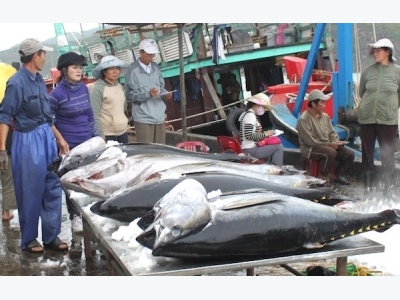What will Vietnams seafood industry do if it receives yellow card from the EU?

Vietnam has been warned that it will receive a yellow card if it doesn’t implement EU demands on fighting IUU (illegal, unreported and unregulated) fishing.
Ngo Viet Hoai, deputy general director of Ba Ria – Vung Tau Seafood Processing & Import/Export Company, said if the EU gives a yellow card warning, 100 percent of seafood containers to be exported to the EU will be subject to inspection in terms of fishing sources.
If so, there will be two possible scenarios. If exports can receive customs clearance, enterprises will have to pay 700 euros for every container stored at ports during the 3-4 week inspection. If exports are refused and forced to return to Vietnam, enterprises will have to pay 4,000-5,000 euros for every container.
If exports can receive customs clearance, enterprises will have to pay 700 euros for every container stored at ports during the 3-4 week inspection. If exports are refused and forced to return to Vietnam, enterprises will have to pay 4,000-5,000 euros for every container.
“This will push the production cost up, thus making Vietnam’s products uncompetitive in the EU market,” Hoai said.
The EU is one of the three largest export markets for Vietnam seafood exporters. Every year, Vietnam exports $1.9-2.2 billion worth of caught seafood products. The EU and the US each consumes 16-17 percent of the exports, worth $350-400 million.
VASEP’s (Vietnam Association of Seafood Exporters and Producers) deputy secretary general Nguyen Hoai Nam has asked VASEP member companies to strictly implement the EU demand or Vietnam may lose the market.
If the EU gives yellow card, Vietnam would have six months to fix problems. After that period, if the EU concludes that the situation has not improved, a red card would be given and Vietnam will have no more opportunities to export caught seafood products to the market.
More seriously, the seafood exports to the US and other potential markets would also be affected. The US is also planning to set up a system to control seafood imports to prevent illegal fishing, expected to be operational from January 1, 2018.
Deputy Minister of Agriculture and Rural Development Vu Van Tam warned that it will be not easy to implement regulations on fighting against illegal fishing. A volume of work needs to be done promptly, including amendments of laws, tightening of control over fishing boats and fishing activities and tracing origin.
Nguyen Thi Thu Sac from VASEP also said this was a difficult task. Vietnam’s fishing boats are small-capacity ones, so it is very difficult to position them, especially when the number of boats is high.
“It is not only necessary to upgrade fishing boats, but also to train boat owners about illegal fishing. It will take time to do these things,” she said.
Related news
Tools

Phối trộn thức ăn chăn nuôi

Pha dung dịch thủy canh

Định mức cho tôm ăn

Phối trộn phân bón NPK

Xác định tỷ lệ tôm sống

Chuyển đổi đơn vị phân bón

Xác định công suất sục khí

Chuyển đổi đơn vị tôm

Tính diện tích nhà kính

Tính thể tích ao




 US’s monitoring programme worries Vietnamese seafood firms
US’s monitoring programme worries Vietnamese seafood firms  Ca Mau's shrimp exports hit more than US$750…
Ca Mau's shrimp exports hit more than US$750…